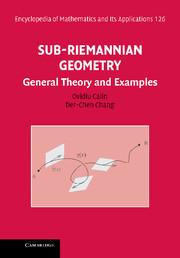12 - Hörmander Manifolds
from Part II - Examples and Applications
Published online by Cambridge University Press: 05 May 2013
Summary
Definition of Hörmander Manifolds
The step of a sub-Riemannian manifold (M, D) at a point p is equal to 1 plus the maximum number of iterations of the Lie brackets of horizontal vector fields needed to be taken to generate the tangent space TpM. The sub-Riemannian manifolds with step 2 everywhere correspond to Heisenberg manifolds, while those with the constant step 1 correspond to Riemannian manifolds. Any manifold that has the step greater than or equal to 3 at one or more points falls into a new category of sub-Riemannian manifolds, which we shall call Hörmander manifolds.
We have the following definition similar with the one about Heisenberg manifolds.
Definition 12.1.1.A Hörmander manifold is a sub-Riemannian manifold (M, D, g) such that:
• the distribution D is bracket generating, with points where the step is at least 3
• there are k, k < dim M, locally defined horizontal vector fields on M, such that
g(Xi, Xj) = δijand Dp = span{X1,…, Xk}p, for all p ∈ M.
On a Hörmander manifold the Lagrangian and the Hamiltonian formalisms are no more equivalent. In this case we make the distinction between the geodesics obtained by one or the other formalisms.
- Type
- Chapter
- Information
- Sub-Riemannian GeometryGeneral Theory and Examples, pp. 302 - 350Publisher: Cambridge University PressPrint publication year: 2009

